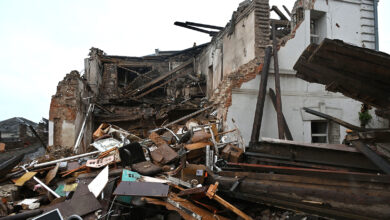The entrance to the Geology Museum in Cairo, with its sad grey appearance and busy location a few meters away from the Maadi corniche, doesn't exactly lure in visitors. An outdoor alley leading to the museum is bordered by different types of rocks, some named on plasticized labels and others left to the viewer’s imagination.
However, this first impression of general haphazardness–so common for the city's less popular museums–is erased as soon as one enters the vast pre-fabricated building and its three distinct collections. In spite of appearances, the Geology Museum can turn a novice into a lover of rocks.
What attracts the eye immediately is not the museum’s rich collection of fossilized sea shells or the numerous marble samples showcased in some of the many display cabinets. No, what any visitor–scholar or neophyte alike–will almost certainly immediately gravitate to are the vertebrate fossils, recreated and proudly displayed in the museum's central space. A displayed cast fossilized specimen of Moeritherium, an animal approximately the size of a large pig with an elongated body and short legs that lived in Egypt about 40 million years ago, would have spent most of its life underwater before being unearthed in the Qasr al-Sagha and the Gabal Qattrani formations in Fayoum and delivered to the museum.
The fossilized remains of another impressive long-extinct vertebrate, the vegetarian Arsinoitherium, are housed in the display cabinets, and a complete model of the rhinoceros-like animal is showcased at only one-fifth of its actual size. Its impressive head boasted two monumental horns on the nasal bones in addition to two small ones on the frontals. The remains of this extraordinary-looking fossilized skeleton were also discovered in Fayoum and are thought to date back 34 million years.
Another impressive specimen, locked inside a side display window, is a fossilized 15-meter long whale’s spinal cord, its huge vertebras and flattened face indicating the animal's vast size. Well-preserved fossilized skeletons of this ancient whale, called Basilosaurus, are fairly common in the North of Fayoum's Wadi al-Rayan.
Fossilized fish, although smaller than their mammal counterparts, are also worth a look at, their scaly skin embedded in the surrounding rock and turned into stone during fossilization, a process that replaces minerals in the bones with rock minerals. 96-million-year-old dinosaur bones–humerus, ribs and metacarps mostly—preserved in mangrove deposits are also on display, along with the fossilized prints of the herbs and leaves that constituted their diet.
The museum’s second collection focuses on minerals and rocks and is rich and varied, although not as mesmerizing as the dinosaurs are for visitors who are not scholars or academics. But even the novice might take an interest in the variety of stones.
Thanks to a well-organized classification the journey through the rock collection is less painful than expected. Rocks are organized according to their types, while minerals are arranged by chemical composition and exhibited in groups. Native elements like gold, silver, copper and sulfur are displayed together, while minerals like gypsum, anhydrite, barite, celesite and epsomite constitute a separate group.
Some written information glued in the display windows draws a correlation between the rocks used to build Egypt's ancient temples and the rocks on display. Chephren Diorite, for instance, is a rock that was commonly used to build statues of pharoahs in the Fourth Dynasty. In an isolated glass window, many flint arrow heads from the Neolithic period are on display, along with a well-preserved sickle blade and a pick axe, from northern Europe. The museum’s pride and joy seems to be its collection of meteorites–supposedly originating from Mars–collected from Gabel Kamal in the western desert.
The museum's final collection consists of invertebrate fossils from various geological periods, organized in a chronological order, also called “stratigraphics sequences.” Starting from the oldest epoch, the Cambrian, the Ordovician and the Silurian, all the way to the Jurassic epoch, each time period is characterized by particular fossils. Illustrated by a colored map of the tectonic evolution of the earth, this classification becomes somewhat clearer.
Cairo's Geology Museum has undeniable scientific interest, but is mostly geared toward scholars and geology aficionados rather than as an educational journey for the average layperson. As more and more local museums see the worth of presenting even the most esoteric collections in an accessible way–the Museum of Islamic Art, the Egyptian Museum–perhaps the Geology Museum will follow suit.
It has, after all, at its disposal one of nature's most enticing artifacts: the skeleton. The Moeritherium would surely stop traffic.




